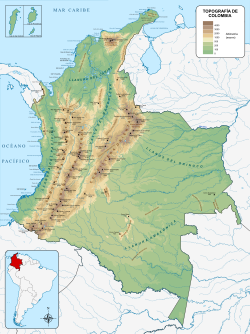Flora
Natural fragmentation of the western moist forests has resulted in rapid evolution of new endemic species. Around 10,000 species of plants have been reported, of which about 2,500 are endemic. The forest has a dense canopy that exceeds 30 metres (98 ft) in height, and has many lianas and epiphytes, including many endemic species. Epiphytes of the Araceae and Cyclanthaceae families are abundant on the lower trunks of the trees. There are also mosses, lichens, ferns and palms in the dense understory. 1,250 species of plants in 136 families have been found in a single area of 100 hectares (250 acres). According to a 1990 report, 122 new orchid species had recently been identified. 43 of the species are endemic.
Emergent species, which may exceed 60 metres (200 ft) in height, include the strangler fig ( Ficus dugandii ). Large, dominant canopy trees include Brosimum utile , Carapa guianensis , Guarea kunthiana and Virola dixonii . Other trees include Clarisia racemosa , Matisia coloradorum , Pourouma chocoana , Pouteria species, Pseudolmedia eggersii and Symphonia globulifera . The endemic tree Humiriastrum procerum grows to the north of the Guayllabamba River, and is often logged for use in construction. Common understory species include the Iriartea deltoidea and Wettinia quinaria palms. Rare species such as Dicliptera dodsonii are found at the Río Palenque Scientific center in Esmeraldas. There are records of rare or extinct flora such as Carapa megistocarpa and Erythrochiton carinatus .
Fauna
According to a 1990 report, 5 new mammal species had recently been identified. The jaguar (Panthera onca) is endangered. Other endangered mammals include Baird's tapir (Tapirus bairdii), equatorial dog-faced bat (Molossops aequatorianus) and Geoffroy's spider monkey (Ateles geoffroyi). Endangered reptiles include Boulenger's least gecko ( Sphaerodactylus scapularis ), green sea turtle (Chelonia mydas) and hawksbill sea turtle (Eretmochelys imbricata). The American crocodile (Crocodylus acutus) is also threatened.
650 species of birds were identified in a 1993 survey, of which many are threatened. Species found in the most humid areas include the Baudo guan (Penelope ortoni), Berlepsch's tinamou (Crypturellus berlepschi), blue-whiskered tanager (Tangara johannae), brown wood rail (Aramides wolfi), crowned woodnymph (Thalurania colombica), El Oro parakeet (Pyrrhura orcesi), El Oro tapaculo (Scytalopus robbinsi), indigo flowerpiercer (Diglossa indigotica), long-wattled umbrellabird (Cephalopterus penduliger) and scarlet-breasted dacnis (Dacnis berlepschi). Species found in less humid areas include grey-backed hawk (Pseudastur occidentalis), ochraceous attila (Attila torridus) and rufous-headed chachalaca (Ortalis erythroptera). Humboldt's sapphire (Hylocharis humboldtii) is found only in the mangroves to the north. Species that have almost been wiped out due to hunting and habitat fragmentation include crested guan (Penelope purpurascens), great curassow (Crax rubra), great green macaw (Ara ambiguus), great tinamou (Tinamus major) and harpy eagle (Harpia harpyja). Endangered birds include banded ground cuckoo (Neomorphus radiolosus), Baudo guan (Penelope ortoni), Esmeraldas woodstar (Chaetocercus berlepschi), great green macaw (Ara ambiguus), grey-backed hawk (Pseudastur occidentalis), grey-cheeked parakeet (Brotogeris pyrrhoptera), rufous-brown solitaire (Cichlopsis leucogenys) and slaty becard (Pachyramphus spodiurus).
Endangered amphibians include Rio Pescado stubfoot toad ( Atelopus balios ), elegant stubfoot toad (Atelopus elegans), phantasmal poison frog (Epipedobates tricolor), horned marsupial frog (Gastrotheca cornuta), Pichincha rocket frog ( Hyloxalus toachi ), Pristimantis colomai , spring robber frog ( Pristimantis crenunguis ), Alto Tambo rain frog ( Pristimantis degener ), hotel robber frog ( Pristimantis tenebrionis ), blue-spotted toad ( Rhaebo caeruleostictus ) and Rio Pitzara robber frog ( Strabomantis helonotus ).


